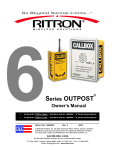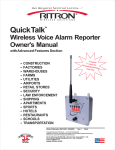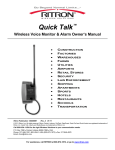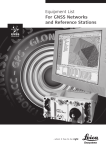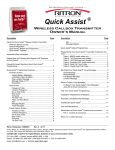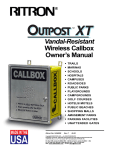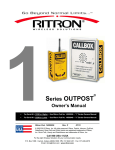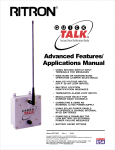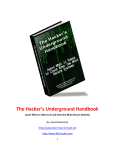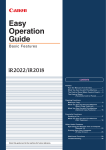Download Ritron RQT-152-RCVR Owner`s manual
Transcript
® Q uick Assist ® WIRELESS CALLBOX TRANSMITTER Basic Owner's Manual MODELS: RQT- 150-PB (VHF) RQT- 450-PB (UHF) Optional Message Placard Pt. No. 14280011 installed on RQT-PB. Website: www.ritron.com Pub. No. 14500019 Rev.H 10-02 Copyright© 2002,1999 RITRON, INC. ALL RIGHTS RESERVED RITRON, Quick Assist, and Quiet Call are registered trademarks of RITRON, INC. Quick Talk is trademark of RITRON, INC. P.O. Box 1998, Carmel, IN 46032-1998 505 W. Carmel Dr., Carmel, IN 46032 USA PH: 317-846-1201; 800-USA-1-USA (800-872-1872) FAX: 317-846-4978 E-mail: [email protected] qtm9322b.pm5 TABLE OF CONTENTS DESCRIPTION WHAT THIS MANUAL COVERS PAGE WHAT THIS MANUAL COVERS .................................... ii WARNINGS AND CAUTIONS ........................................ ii This manual covers the basic operation of the Quick Assist Wireless Shopper's Callbox Transmitter. For most applications, this is all the information you will need. However, if you have specific questions or need assistance call Ritron at 317-846-1201, or visit the Ritron website at www.ritron.com. ACCESSORIES AND OPTIONS .................................... ii INTRODUCTION ............................................................ 1 General Information ............................................ 1 Care and Maintenance ....................................... 1 PROGRAMMING ............................................................ 2 Before Programming the Unit ............................. 2 Programming the Transmitter Frequency .......... 2 Quiet Call Coded Squelch Codes ...................... 2 Digital Quiet Call Squelch Codes ...................... 2 Transmit Codes .................................................. 3 Quiet Call Tone Codes ....................................... 3 Programming the Initial Message ...................... 4 Programming Voice Phrase Repetitions ........... 4 Programming the All Clear Message ................. 4 Recording Low Battery Message ....................... 4 Limiting the Number of Transmissions ............. 4 Setting Narrow/Wide-band Channels ................ 5 Companded Audio Selector ................................ 5 Settings for Battery type ....................................... 5 Connecting to an External Power Supply ........... 6 WARNING IMPORTANT SAFETY INFORMATION NOTICE: The Quick Talk unit should not be used to report conditions relating to safety of life or property. To reduce the risk of fire, electric shock or personal injury, follow these basic safety instructions when using this unit. 1. Read and follow all instructions. 2. Disconnect the unit before cleaning. Do not use liquid or aerosol cleaners. CONTROLS & CONNECTORS ...................................... 7 3. Use only approved power sources for the unit. INSTALLATION .............................................................. 8 4. During thunderstorms, avoid contact with this unit and any external antenna system or wiring. 5. The Quick Talk switch and external power terminals are connected internally to the antenna connector. If the Quick Talk switch or power supply terminals contact high voltage, a hazardous condition may exist in that contacting the antenna could prove injurious or even fatal. RITRON WIRELESS SOLUTIONS ................................. 9 F.C.C. LICENSING ......................................................... 11 WARRANTY ................................................................. 11 ACCESSORIES FOR QUICK ASSIST 6. In general, the switches you connect to the Quick Talk are to be independent dry contact switches, and not part of any other "live" electrical circuit Item Description 14280010 14280011 14280009 RAM-1545 25605600 3-sided "NEED SALES HELP?" Placard 3-sided "NEED SERVICE?" Placard 1-sided "NEED SALES HELP?" Placard Magnet-Mount Antenna Cover Gasket 7. If you are unsure whether your installation will be safe, contact an experienced electrician or electronics technician. These replacement and optional items are available from Ritron and its authorized dealers. For assistance, call RITRON at 800-USA-1-USA (800-872-1872) or visit us at www.ritron.com ii qtm9322b.pm5 QUICK ASSIST APPLICATION The Quick Assist is a radio transmitter, specialized for retail or commercial use, and preprogrammed to transmit a custom-recorded "assistance needed" message when the Message push-button is pressed for customer assistance. Personnel know from these message transmissions in which specific areas a customer needs assistance. The Quick Assist is also equipped with a Reset push-button for the use of personnel. When the Reset push-button is pressed (which stops the "assistance needed" message and resets the unit), the Quick Assist transmits a custom-programmed "assistance no longer needed" message, to further inform store personnel. CAUTION ! ! Remove the unit from the wall or other mounting surface before changing batteries. The Cover Gasket (Pt. No. 25605600) must be in good condition and correctly installed to seal against environFIG-1: COVER GASKET mental hazards for outdoor operation. COVER GASKET CAUTION: If the Cover Gasket is crimped, (IN THE RECESS) damaged or incorrectly installed, rain will leak into the unit, causing severe damage, IN-LINE CONNECTORS and voiding the warranty. Replace any FROM RESET damaged Gasket. SWITCH a. Place the Cover Assembly on a flat horizontal surface with the recessed side up. Carefully seat the Gasket in the recess of the Cover (refer to FIG-1 at right). b. Reconnect the In-line Connectors (refer to page CONNECT IN-LINE 7). With the Gasket side of the Cover Assembly up, CONNECTORS FROM insert the case into the recess. RESET SWITCH c. Replace the four (4) Cover screws. Snug down, but do not overtighten the screws; excessive force can break the plastic enclosure material. CARE & MAINTENANCE Batteries: Use only fresh, new alkaline batteries when programming Quick Assist. Acceptable brands and types are: Duracell MX1500B, Eveready E91, Rayovac 815, or equivalent. NOTE: Refer to page 6 of this manual for information on using rechargeable NiCad AA batteries, charged by an optional external 12 Volt DC power supply. Estimated Battery Life: Starting with a fresh set of AA alkaline batteries, Quick Assist can transmit about 7,000 voice messages over a period of one year before the batteries will need replacement. Automatic Low Battery Alert Message: If the battery voltage drops below approximately 6 Volts, the Quick Assist transmits the factory prerecorded message "Low Battery" every 60 minutes. When this occurs, replace the batteries promptly within a day or so. Temperature: The Quick Assist is designed to operate between -22 and +140 F. Within this temperature range, good radio performance also depends on specifications of batteries powering the unit. Alkaline battery power decreases in extreme colde.g.: a power loss of 20% at 14 F. Like all electronic equipment, Quick Assist should not be subjected to extreme heat. A shaded area is an ideal outdoor location. Moisture: When Cover Gasket (above) and Antenna sealant (page 8) recommendations are followed, the Quick Assist is highly weather-resistant to outdoor environments. Do not immerse the unit in water. Vibrations/ Shocks: Although it is of rugged design, the Quick Assist cannot be expected to survive extreme abuse. Chemicals: Do not use harsh, corrosive or abrasive chemicals to clean the Quick Assist case; use only a cloth moistened with water. Do not attempt to clean the printed circuit board, which is located inside the housing. For assistance, call RITRON at 800-USA-1-USA (800-872-1872) or visit us at www.ritron.com 1 qtm9322b.pm5 1. 2. 3. 4. BEFORE PROGRAMMING THE QUICK ASSIST: Remove the Message Panel by pulling forward on the top of it. Remove the (4) large screws at the corners of the gray enclosure. Lift the cover from the unit. Use care to not damage or disturb any exposed internal components. Plug a telephone unit that passes the following test into the telephone jack on the radio board. IMPORTANT IMPORTANT The telephone must be capable of "Pulse" mode dialing. Most specialized and office telephones, speaker The telephone must be capable of dials "Pulse" mode dialing. Most specialized and officeCANNOT telephones, speaker phones, telephones with lighted and those that generate only Touch Tones BE USED tophones, those withthe lighted dials and that generate only Touch Tones CANNOT BE USED to program the Quick Talk. program Quick Talk. IfMany the telephone has a modehave selection switch, switch it must for be set "P" (Pulse), rather thanA"T" (Tone), to program modern telephones a selection "P"to (Pulse) and "T" (Tone). "Pulse" mode tele- the Quick phoneTalk. generates a rapid series of clicks (rather than Touch Tones) with each dialed digit. If the telehas this must modehave selection it must be set to plug. "P" (Pulse) to program the Quick Talk. - phone The telephone a cordswitch, with a standard modular The telephone mustfor have a cord with standard it modular plug. - - Test the telephone suitability byaplugging into the telephone jack of the Quick Talk, then dialing "O" A repeating busy signal in the telephone earpiece indicates is acceptable programming the - (Operator). Test the telephone for suitability by plugging it into the telephone jack of theitQuick Talk, thenfor dial "O" (Operator). A Quick Talk. busy signal in the telephone earpiece indicates it is acceptable for programming the Quick Talk. repeating 5. Disconnect the Antenna and the Rest Push-button in-line connectors. See FIG-2, page 4. 6. Remove batteries from the unit. Install a fresh set of six AA alkaline batteries, matching polarity marks on the batteries with the marks in the battery holder. 7. Reconnect the Antenna connector to the antenna, and the Reset in-line connector to the Reset Push-button. IMPORTANT: THE ANTENNA AND RESET CONNECTORS MUST BE CONNECTED in order to program the unit !! 8. Program the Quick Assist as follows: A. TO PROGRAM THE TRANSMITTER FREQUENCY: B. TO PROGRAM THE QUIET CALL SUB-AUDIBLE CODED SQUELCH INTERFERENCE ELIMINATOR: 1. Determine the frequency of your radio system. 2. Find your frequency in Table 1, page 2, then determine its corresponding two-digit code. If your frequency is not listed in Table 1, skip to Step 7. Otherwise, go on to Step 3: For frequencies listed in Table 1: 3. Pick up the telephone receiver and listen for the acknowledge tone. 4. Dial 11, then enter the digits of your frequency code from Table 1. EXAMPLES: If your Quick Assist is a VHF RQT-150-PB operating on the frequency 154.570 MHz, dial 1102. If your Quick Assist is a UHF RQT-450-PB operating on the frequency of 467.925 MHz, dial 1108. For QC codes: 2. Find your QC tone frequency and its corresponding 2-digit code in Table 2, page 2. NOTE: If your radio system does not use coded squelch, program No Tone Code 44. 3. Pick up the telephone receiver and listen for the acknowledge tone. 4. Dial 21, then enter the 2-digit code from Table 2. If your QC frequency is 103.5 (Code 13), dial 2113. EXAMPLE: 5. Quick Assist responds with a single beep to indicate it has programmed the QC code. 5. Quick Assist responds with a single beep to indicate the transmitter frequency programming is completed. 6. You may either continue programming additional features, or you may dial 999 and hang up the telephone to stop programming. 6. You may either continue programming additional features, or you may dial 999 and hang up to stop programming. For DQC codes: 7. Find your 3-digit DQC Code in Table 3, page 2. If your code does not appear in Table 3, call your radio service provider or Ritron. For frequencies not listed in Table 1: 7. Pick up the telephone receiver and listen for the acknowledge tone. 8. Dial 12, then the first six digits of your frequency. EXAMPLES: If your Quick Assist is a VHF RQT-150-PB operating on a frequency of 153.220 MHz, dial 12153220. If your Quick Assist is a UHF RQT-450-PB operating on a frequency of 464.3125 MHz, dial 12464312. 8. Pick up the telephone receiver and listen for the acknowledge tone. 9. Dial 22, then enter the 3-digit DQC code from Table 3. If your DQC code is 131, dial 22131. EXAMPLE: 10. Quick Assist responds with a single beep to indicate it has programmed the DQC code. 9. Quick Assist responds with a single beep to indicate it has programmed the transmitter frequency. 10. You may either continue programming additional features, or you may dial 999 and hang up the telephone to stop programming. 1. Determine if your radio system uses QC- or DQCcoded tones. To program DQC tones, skip to Step 7. 11. You may either continue programming additional features, or you may dial 999 and hang up the telephone to stop programming. (Programming Instructions continued on page 4) For assistance, call RITRON at 800-USA-1-USA (800-872-1872) or visit us at www.ritron.com 2 qtm9322b.pm5 TABLE 1: TRANSMIT FREQUENCY CODES (VHF Business Band) TABLE 2: QUICK ASSIST QC CODE 01 02 03 04 05 06 07 08 09 10 11 12 13 14 15 16 17 18 19 20 21 22 23 24 25 26 QUICK ASSIST FREQ. CODE MHz 01 02 03 04 154.600 154.570 151.625 151.955 05 06 07 08 67.0 71.9 74.4 77.0 79.7 82.5 85.4 88.5 91.5 94.8 97.4 100.0 103.5 107.2 110.9 114.8 118.8 123.0 127.3 131.8 136.5 141.3 146.2 151.4 156.7 162.2 QUICK ASSIST FREQ. CODE Model RQT-150-PB Frequency Color Model RQT-450-PB MHz Frequency Color 01 02 03 04 467.7625 ..... J 467.8125 ..... K 464.5500 ..... Yellow Dot 464.5000 ..... Brown Dot 151.925 154.540 154.515 154.655 05 06 07 08 467.8500 ...... Silver Star 467.8750 ...... Gold Star 467.9000 ...... Red Star 467.9250 ...... Blue Star 09 10 11 12 151.685 151.715 151.775 151.805 09 10 11 12 469.2625 462.5750 ...... White Dot 462.6250 ...... Black Dot 462.6750 ...... Orange Dot 13 14 15 16 151.835 151.895 154.490 151.655 13 14 15 16 464.3250 464.8250 469.5000 469.5500 17 18 151.745 151.865 17 18 19 20 463.2625 464.9125 464.6000 464.7000 Other Radio Brands Tone QUIET CodeCALL Freq. ( Hz ) (UHF Business Band) .... .... .... .... Green Dot Blue Dot Red Dot Purple Dot TONE CODES Other Radio Brands Tone Code QUICK ASSIST QC CODE XZ XA WA XB SP YZ YA YB ZZ ZA ZB 1Z 1A 1B 2Z 2A 2B 3Z 3A 3B 4Z 4A 4B 5Z 5A 5B 27 28 29 30 31 32 33 34 35 36 37 38 39 40 41 42 43 *44 45 46 47 48 49 50 51 Freq. ( Hz ) 167.9 173.8 179.9 186.2 192.8 203.5 210.7 218.1 225.7 233.6 241.8 250.3 69.4 159.8 165.5 171.3 177.3 No Tone 183.5 189.9 196.6 199.5 206.5 229.1 254.1 TABLE 3: DIGITAL QUIET CALL CODES Other Radio Brands Tone Code 6Z 6A 6B 7Z 7A M1 -------------------- Normal Invert 047 244 464 627 174 205 223 226 ........ ........ ........ ........ ........ ........ ........ ........ 051 445 023 032 243 244 245 251 054 065 071 072 ........ ........ ........ ........ 413 271 306 245 073 074 114 115 Normal Invert Normal Invert 023 025 026 031 ........ ........ ........ ........ 074 263 134 411 445 464 465 466 ........ ........ ........ ........ 043 026 331 662 032 043 047 051 ........ ........ ........ ........ 351 025 072 165 503 ........ 506 ........ 516 ........ 532 ........ 162 073 432 343 261 263 265 271 ........ ........ ........ ........ 732 205 156 065 546 ........ 565 ........ 606 ........ 612 ........ 132 103 631 346 ........ 506 ........ 174 ........ 712 ........ 152 306 311 315 331 ........ 071 ........ 664 ........ 423 ........ 465 624 ........ 627 ........ 631 ........ 632 ........ 632 031 606 624 116 125 131 132 ........ 754 ........ 365 ........ 364 ........ 546 343 346 351 364 ........ ........ ........ ........ 532 612 243 131 654 ........ 662 ........ 664 ........ 703 ........ 743 466 311 565 134 143 152 155 ........ ........ ........ ........ 223 412 115 731 365 371 411 412 ........ 125 ........ 734 ........ 226 ........ 143 712 ........ 723 ........ 731 ........ 732 ........ 114 431 155 261 156 162 165 172 ........ ........ ........ ........ 265 503 251 036 413 423 431 432 ........ ........ ........ ........ 734 ........ 371 743 ........ 654 754 ........ 116 054 315 723 516 For assistance, call RITRON at 800-USA-1-USA (800-872-1872) or visit us at www.ritron.com 3 qtm9322b.pm5 (Programming Instructions continued from page 2) C. TO PROGRAM THE ASSISTANCE NEEDED MESSAGE: F. TO PROGRAM THE "LOW BATTERY" MESSAGE: 1. Pick up the telephone receiver and listen for the acknowledge tone. 1. Pick up the telephone receiver and listen for the acknowledge tone. 2. Dial 312. Quick Assist responds with three short tones to prompt you to begin speaking, then records the message. This message is to be no longer than 8 seconds. Remember: speak loudly and clearly. EXAMPLE: Customer needs assistance in Aisle 9. 2. Dial "35". Quick Assist responds with three short tones to prompt you to begin speaking, then records the message. This message is to be no longer than 1.5 seconds. EXAMPLE: "Low battery Aisle 9" 3. When you have finished speaking, press and release the telephone flash-hook. 4. You may either continue programming additional features, or you may dial 999 and hang up the telephone to stop programming. NOTE: To review your recorded message, dial "412". 3. When you have finished speaking, press and release the telephone flash-hook. 4. You may either continue programming additional features, or you may dial 999 and hang up the telephone to stop programming. NOTE: To review your recorded message, dial "45". G. TO PROGRAM THE "ASSISTANCE NEEDED" MESSAGE REPEAT LIMIT: (DEFAULT SETTING IS 8 TIMES) D. TO PROGRAM TIME BETWEEN REPEATED MESSAGES: (DEFAULT SETTING IS 30 SECONDS) 1. Look up the code for the desired number of message repeats on Table 5, below. 1. Look up the code for the desired time between messages on Table 4, below. 2. Pick up the telephone receiver and listen for the acknowledge tone. 2. Pick up the telephone receiver and listen for the acknowledge tone. 3. Dial "612", then the code digit from Table 5. If you select 3 times as the message repeat limit, dial 6123. EXAMPLE: 3. Dial 512, then the code digit from Table 4. EXAMPLE: If you select 2 minutes as the time between messages, dial 5124. 4. Quick Assist responds with a single beep to indicate it has programmed the message repeat limit. 4. Quick Assist responds with a single beep to indicate it has programmed the time between messages. 5. Dial 999 and hang up the telephone to stop programming. 5. You may either continue programming additional features, or you may dial 999 and hang up the telephone to stop programming. TABLE 5: MESSAGE REPEAT LIMIT TABLE 4: TIME BETWEEN MESSAGES CODE NUMBER No Message ............................................. 0 On Changes Only ..................................... 1 30 seconds .............................................. 2 1 minute ................................................... 3 2 minutes ................................................. 4 5 minutes ................................................. 5 10 minutes ............................................... 6 30 minutes ............................................... 7 1 hour ...................................................... 8 2 hours .................................................... 9 CODE NUMBER 1 time ...................................................... 1 2 times ..................................................... 2 3 times ..................................................... 3 4 times ..................................................... 4 5 times ..................................................... 5 6 times ..................................................... 6 7 times ..................................................... 7 8 times ..................................................... 8 Repeat forever; no limit ............................. 9 DEFAULT DEFAULT ! ! ! IMPORTANT ! ! ! E. TO PROGRAM THE ASSISTANCE IS NO LONGER NEEDED MESSAGE: 1. Pick up the telephone receiver and listen for the acknowledge tone. If your Quick Assist unit fails to operate correctly, or is programmed incorrectly, put the unit into default Quick Assist mode using the following procedure: 2. Dial 311. Quick Assist responds with three short tones to prompt you to begin speaking, then records the message. This message is to be no longer than 8 seconds. EXAMPLE: Aisle 9 OK. 3. When you have finished speaking, press and release the telephone flash-hook. 4. You may either continue programming additional features, or you may dial 999 and hang up the telephone to stop programming. NOTE: To review your recorded message, press "41 1. Pick up the telephone receiver and listen for the acknowledge tone. 2. Dial the correct option (A or B below), to restore factory defaults; a short beep indicates successful completion. A. For RQT-150-PB, dial 978. B. For RQT-450-PB, dial 979. 3. Dial 814 to put the unit into Quick Assist mode; a short beep indicates successful completion. 4. Program Sections A through F, above. Section G is optional. 5. Programming of the Ritron Quick Assist is complete! For assistance, call RITRON at 800-USA-1-USA (800-872-1872) or visit us at www.ritron.com 4 qtm9322b.pm5 SETTING NARROW OR WIDE-BAND CHANNELS Determine the frequency of your radios. This can be done by checking with your radio dealer, or if you are using Color Dot radios, match the color dot to the frequency table on Page 2. As a general rule, if your frequency has three or less numbers past the decimal point, your radio is set for wideband. Example 154.570 MHZ, 462.625 MHz. If your frequency has more than three numbers past the decimal point, it is probably set for narrowband. Example: 467.7625 MHz, 467.8125. Wide: (Refer to FIG-2) To set your Quick Assist into wideband position, place the Transmitter Bandwidth Select Jumper so that both pins of the 2 pin connector are covered by the jumper. Narrow: (Refer to FIG-2) To set your Quick Assist into narrowband position, place the Transmitter Bandwidth Select Jumper so that only 1 pin of the 2 pin connector is covered by the jumper. Narrow-Band Wide-Band FIG2. J102 SETTING FOR NARROW OR WIDE-BAND OPERATION COMPRESSED/NOT-COMPRESSED AUDIO SELECTOR JUMPER Some two-way radios have a feature referred to as companding. It is a way of eliminating background hiss or noise, making the radio sound clearer. Companding is a combination of audio COMPression in the transmitter and audio exPANDing in the receiver. The Quick Assist can be set for audio compression by means of a program jumper. To determine if your existing 2-way radios are using the Companding feature, you can check the radios User Manual, contact your radio dealer, or call Ritron for help. Not-Compressed: (Refer to FIG-3) To set the Quick Assist for standard audio or notcompressed, place the jumper so that the middle pin and the pin closest to the word NON-COMP are covered by the jumper. Compressed: (Refer to FIG-3) To set the Quick Assist for compressed audio, place the jumper so that the middle pin and the pin closest to the word COMP are covered by the jumper. Not-Compressed Compressed FIG3. POSITION FOR NOT-COMPRESSED/ COMPRESSED AUDIO IMPORTANT You may change the Transmitter Bandwidth and Compressed/NonCompressed Audio jumper settings without re-recording your custom voice message. If you are unable to determine if your portable radio does or does not use the companding feature, we suggest the following: 1. Leave the jumper in the factory default setting NON-COMP. 2. Activate the transmitter of the Quick Talk or Quick Assist (I or II) and listen to the message from your portable radio. If the received audio is acceptable, skip the rest of this section, if its not acceptable continue to step #3. 3. Change the jumper setting to the COMP position and activate the Quick Talk or Quick Assist (I or II) transmitter again, and listen to the voice message. Place the jumper in the setting that produces the best received audio message in the radio you will be using. For assistance, call RITRON at 800-USA-1-USA (800-872-1872) or visit us at www.ritron.com 5 qtm9322b.pm5 J103 JUMPER SETTINGS FOR BATTERY TYPE NOTE: When programming, use either fresh Alkaline batteries (or an external power supply), to power the Quick Assist. When programming is finished, you may either insert Ni-Cd batteries or leave Alkaline batteries in place. WARNING: DO NOT attempt to charge Alkaline batteries from an external +12VDC power supply. When powering Quick Assist with ALKALINE BATTERIES, set J103 as follows to disconnect the charging current paths: a. To set the Quick Assist for use with alkaline batteries, move Jumper J103 to cover only one pin of the jumper base, as shown in FIG-4; this setting prevents the flow of charging current. Alkaline b. Dial "943" to program the Quick Assist for use with alkaline batteries. NI-CD FIG4. J103 POSITION FOR USE WITH ALKALINE OR NI-CD BATTERIES When powering Quick Assist with NI-CD BATTERIES, set J103 as follows to connect the charging current paths: c. Cover both pins with Jumper J103, as shown in FIG4, to charge the Ni-Cd batteries from the External Power connection. d. Dial "944" to adjust the Quick Talk voltage; the unit then transmits a "Low Battery" phrase. NOTE: Because Ni-Cd batteries self-discharge rapidly, constantly charge them with external +12VDC power. CONNECTING AN EXTERNAL 12 VDC POWER SUPPLY TO CONNECT AN EXTERNAL 12 VDC POWER SUPPLY: The standard Quick Assist is not set-up for use with an external power supply. + To modify the Quick Assist for use with an external power supply, use the following instructions. 1. Carefully drill or punch a 0.484" hole in the bottom of the Quick Assist enclosure. 2. Install Ritron #02500127 strain relief into the drilled hole. 3. Use Ritron #RPS-203 Power Supply (11-15 VDC, 200 mA), or equivalent, to power the Quick Assist. The Quick Assist requires 11-15 VDC, 150 mA minimum. 4. - SWITCH 1 EXTERNAL POWER SUPPLY FIG6. Connect the External Power Supply to Quick Assist positive and negative terminals, as shown in FIG-6. EXTERNAL POWER SUPPLY CONNECTIONS For assistance, call RITRON at 800-USA-1-USA (800-872-1872) or visit us at www.ritron.com 6 qtm9322b.pm5 IDENTIFICATION OF CONTROLS AND CONNECTIONS 1 ANTENNA CONNECTOR The antenna radiates radio signals. Before using Quick Assist, make sure the antenna is fastened securely to this connector. See page 8. 2 TELEPHONE JACK The modular telephone jack provides temporary connection to a standard pulse or rotary mode telephone unit, which is used by the owner to program Quick Assist voice messages and other settings. Refer to FIG-7 below. WARNING: DO NOT connect the Quick Assist to a line from the telephone company; doing so will damage the unit, and void the manufacturer's warranty. 3 BATTERY HOLDER The battery holder accommodates the six (6) standard "AA" alkaline cells required to power the Quick Assist. NOTE: ALWAYS INSTALL A FRESH SET of alkaline batteries before programming the unit. 4 SWITCH #1 TERMINALS Switch #1 terminals connect to the unit's front panel (customer) push-button. When the button is pressed and released, the Quick Assist transmits a voice message (typically, a Customer Assistance message). 5 SWITCH #2 TERMINALS Switch #2 terminals connect to the reset switch on the bottom of the unit. When this reset button is pressed and released, the Quick Assist transmits a voice message (typically, a Reset message). 6 EXTERNAL POWER TERMINALS Refer to page 6 for information to connect an external 12 VDC power supply to these terminals. 7 FRONT PANEL (CUSTOMER SERVICE) PUSH-BUTTON When this push-button is pressed and released, the Quick Assist transmits a voice message (typically, a Customer Assistance message). 8 TRANSMITTER BANDWIDTH SELECT JUMPER DO NOT remove this jumper. As described on page 5, this jumper controls selection of wide or narrow bandwidth. 9 BATTERY TYPE SELECT JUMPER DO NOT remove this jumper. As described on page 5 this jumper controls charging the optional Ni-Cd batteries. 10. COMPRESSED/NOT-COMPRESSED AUDIO SELECTOR Do not remove this jumper. The Quick Assist can be used with two-way radios that use "companded audio." For radios with Companded Audio -place the jumper in the COMP position. For radios without Companded Audio - place the jumper in the NONCOMP position. To determine if your radio uses companded audio, call Ritron or your radio supplier. IMPORTANT: Do not remove any other fasteners or further disassemble the Quick Assist unit; doing so risks damage to the unit and voiding the manufacturer's warranty. FIG-7: CONTROL & CONNECTION LOCATIONS O WNER - S U P P L I E D S TANDARD DESK T ELEPHONE S ET, SWITCHED TO P ULSE D IALING MODE 9 Battery Type Selector 3 Battery Holder TO QUICK ASSIST TELEPHONE JACK, (ITEM 2). OWNER-SUPPLIED MODULAR TELEPHONE CORD: DO NOT CONNECT TO TELEPHONE LINE, BUT TO A TELEPHONE SET ONLY. 8 6 External Power Input Terminals 7 Customer Service Push-button Connection 4 Switch #1 Terminals 5 2 Transmitter Bandwidth Select Jumper 1 Antenna Co-Axial to BNC Connector Switch #2 Terminals Standard Modular Telephone Jack 10 Compressed/Not-Compressed Audio Select Jumper For assistance, call RITRON at 800-USA-1-USA (800-872-1872) or visit us at www.ritron.com 7 qtm9322b.pm5 QUICK ASSIST INSTALLATION WHEN YOU ARE FINISHED PROGRAMMING: CAUTION The antenna connection MUST BE SEALED if the Quick Assist is to be used outdoors. See Step 4 at right. Antenna (Adjust to vertical position.) Optional Message Placard Pt. No. 14280010 installed on RQT-PB. Customeraccessible push-button Reset button (on unit bottom) FIG.-8: QUICK ASSIST INSTALLATION BEFORE SEALING AFTER SEALING Overlap sealing tape to include the antenna connection and the top of the RF enclosure 1. Hang up and disconnect the telephone from the internal jack on the Quick Assist. 2. Test the operation of the Quick Assist before putting it into service by activating both switches: first press the Customer Service push-button on the front of the unit, then press the Reset push-button on the bottom of the unit. Listen to the messages received on your radio. 3. Replace the cover and (4) cover screws. Snug down, but do not overtighten the screws; excessive force can break the plastic enclosure material. NOTE: See page 1 for installation of the Cover Gasket. 4. Attach the antenna and seal the connection: a. Insert, rotate and lock the antenna to the Quick Assist antenna jack. b. Orient the antenna in a vertical position. c. Seal the antenna connection to hold the antenna in vertical position, to protect antenna fittings, and to maintain water-resistance of the Quick Assist in wet or outdoor environments. NOTICE: If the unit is to be used outdoors, the antenna connection must be sealed with waterproof, self-fusing tape. Use: Grainger Pt. # 2A459, McMaster-Carr Pt. #7643A34, or RadioShack Pt. # 278-1645 Wrap the connection with sealant tape and press it securely in place. (Refer to sealant instructions.) 5. To install the Optional Message Placard, align it with the center of its hole over the front pushbutton; also align the mushroom head fastener strips on the back of the panel with those on the front of the RQT cover. Press firmly to interlock the strips together, snapping the panel into position. 6. Test for sufficient broadcast range when choosing the location for the Quick Assist unit. For maximum range and coverage, install it as high from ground level as possible. Be aware that metal or wires near the antenna can block or absorb radio transmissions. If the installation is outdoors, choose a wellshaded location. NOTE: An optional high gain antenna is available from Ritron; call 800-USA-1-USA for information. 7. Position the unit as shown in FIG.-8, and secure it in place with screws through the enclosure flanges. Do not overtighten these screws, as you might break the plastic flanges. IMPORTANT: Contact a qualified technician or electrician if you are not certain your installation will work properly and safely. For assistance, call RITRON at 800-USA-1-USA (800-872-1872) or visit us at www.ritron.com 8 qtm9322b.pm5 Complete Wireless Communication SolutionsFrom The Leader in Workplace Two-Way Radio Systems Ritron - We Build Wireless Solutions For nearly 3 decades Ritron has been designing, manufacturing, and supplying reliable, professional wireless communication products for users worldwide. Ritron wireless products will improve the operation, safety, and profitability of any organization by providing instant voice communication between key employees throughout the workplace. Portable Radios Communicate with multiple workgroups instantly with a push-of-the-button. Rugged and lightweight with built-in weather scan (VHF models only) automatically finds NOAA broadcasts. Other features include Interference Eliminator, Loud and Clear Audio, Removable Quick Swap Battery, and Drop-in Charging Capability. Accessories Ritron offers a wide variety of headsets, earsets, remote speaker microphones, multi-unit chargers, and carry holsters to meet all your wireless communication needs. A RITRON EXCLUSIVE Desktop 2-way Base Station 110 VAC or 12 VDC desktop or wall mountable radio that is compatible with any VHF/UHF radio system. Includes built-in Weather Scan (VHF models only), loud audio output for noisy locations, built-in microphone with automatic gain control, and rugged metal housing. Optional Public Address (PA) modification available. Ideal for in-plant schools retail stores jobsite vehicles community repeater systems, loading docks construction trailers or anywhere that fixed two-way communication is needed. For assistance, call RITRON at 800-USA-1-USA (800-872-1872) or visit us at www.ritron.com 9 qtm9322b.pm5 Advantages of Ritron Wireless Products: Unique products and features not available from any other source Adds speed, flexibility, and responsiveness to any organization Fully compatible with virtually any existing two-way radio system Designed to work together as a complete system No monthly service fees or airtime charges Made in the U.S.A. OutPost TM Wireless Radio Callboxes Battery-operated (6 alkaline "D" cells) callboxes, available in basic or rugged models, provide instant wireless communication over existing two-way radio systems without costly trenching, extensive wiring, or dedicated phone lines. A RITRON EXCLUSIVE Ideal for Hotels/Motels Golf Courses Schools, Public Parks Playgrounds Roadsides Marinas Parking Lots or Garages Receiving or Delivery Docks Campuses Shopping Malls Beachs and Pools Campgrounds and Hiking Trails Unattended Gates. It's like being in 2 places at once! Quick Talk TM Wireless Voice Alarm Reporter No need to run wires, phone lines, or pay a person for 24/7 monitoring. The low-cost, battery-operated (6 alkaline "AA" cells) Quick Talk Reporter permits wireless monitoring of virtually any sensor or switch from a two-way radio. When the switch opens or closes, a user recordable "custom" voice message is automatically transmitted to all radios on the same channel frequency. A RITRON EXCLUSIVE Ideal for remote monitoring of power failures liquid levels intrusion or tampering temperature sensing unattended doors to name only a few of the 1000s of applications. For assistance, call RITRON at 800-USA-1-USA (800-872-1872) or visit us at www.ritron.com 10 qtm9322b.pm5 F.C.C. LICENSING AND REGULATIONS The Rules and Regulations of the United States Federal Communications Commission (FCC) require you or your radio service provider to have a license for your radio system before activating the Quick Talk radio transmitter. If you already are operating a licensed radio system, you probably can add a Quick Talk without any changes to that license. The station licensee is responsible for ensuring that transmitter power, frequency and modulation are within the limits specified by the station license, and also for proper operation and maintenance of the radio equipment.These responsibilities include checking the transmitter frequency and modulation periodically, using appropriate methods. Ritron or your Ritron Dealer can assist you with all these requirements. You may also contact the FCC directly by any of the following methods: To obtain copies of FCC forms and instructions use the FCC Fax-On-Demand system at 202-418-0177. Request Document 000600. For more information, go to the FCC Internet Website at: http://www.fcc.gov SAFETY STANDARDS The FCC has adopted a safety standard for human exposure to radio frequency electromagnetic energy emitted by FCC regulated equipment. The Quick Talk conforms to the standards effective at the time of its equipment authorization by the FCC. In general these standards recommend that you: DO NOT allow the antenna to come very close to, or to touch exposed parts of the body, especially the face or eyes, while transmitting. DO NOT transmit near electrical blasting caps or in an explosive atmosphere. DO NOT allow children to play with radio transmitters. BE AWARE of the conditions which cause the unit to transmit. SERVICE - Federal law prohibits you from making any internal adjustments to the transmitter, and from changing transmit frequencies unless you are specifically designated by the licensee. DO NOT ADJUST OR TAMPER with components or the printed circuit board in any manner not directed in this manual. Unauthorized adjustments may render the unit inoperable; repair will be at owner's expense. If your radio equipment fails to operate properly, or if you wish to have the Ritron Quick Talk serviced, contact your authorized dealer, or call Ritron at 317-846-1201 and ask for the Repair Department. RITRON, INC. LIMITED WARRANTY WHAT THIS WARRANTY COVERS: RITRON, INC. ("RITRON") provides the following warranty against defects in materials and/or workmanship in RITRON RQ-150-PB AND RQT-450-PB QUICK ASSIST Wireless Shopper's Callbox units under normal use and service during the applicable warranty period, as stated below. "Accessories" means antennas, chargers, wire, cable and items contained in the programming and programming/ service kits. WHAT IS COVEREDFOR HOW LONG WHAT RITRON WILL DO Quick Assist 1 year * During the first year after date of Telemetry Unit purchase, RITRON will repair or replace the defective product, at RITRON's option, parts and labor included at no charge. Accessories 90 days * * After date of purchase WHAT THIS WARRANTY DOES NOT COVER: Any technical information provided with the covered product or any other products; Installation, maintenance or service of the product, unless this is covered by a separate written agreement with RITRON; Any products not furnished by RITRON which are attached or used with the covered product, or defects or damage from the use of the covered product with equipment that is not covered; Defects or damage, including broken antennas, resulting from: - misuse, abuse, improper maintenance, alteration, modification, neglect, accident or act of God, or, - the use of covered products other than in normal and customary manner, or, - improper testing or installation; Defects or damages from unauthorized disassembly, repair or modification, or where unauthorized disassembly, repair or modification prevents inspection and testing necessary to validate warranty claims; Defects or damages in which the serial number has been removed, altered or defaced. IMPORTANT: This warranty sets forth the full extent of RITRON's express responsibilities regarding the covered products, and is given in lieu of all other express warranties. What RITRON has agreed to do above is your sole and exclusive remedy. No person is authorized to make any other warranty to you on behalf of RITRON. Warranties implied by state law, such as implied warran- ties of merchantability and fitness for a particular purpose, are limited to the duration of this limited warranty as it applies to the covered product. Incidental and consequential damages are not recoverable under this warranty (this includes loss of use or time, inconvenience, business interruption, commercial loss, lost profits or savings). Some states do not allow the exclusion or limitation of incidental or consequential damages, or limitation on how long an implied warranty lasts, so the above limitations or exclusions may not apply to you. Because each covered product system is unique, RITRON disclaims liability for range, coverage, or operation of the system as a whole under this warranty. WHO IS COVERED BY THIS WARRANTY: This warranty is given only to the purchaser or lessee of covered products when acquired for use, not resale. This warranty is not assignable or transferable. HOW TO GET WARRANTY SERVICE: To receive warranty service, you must deliver or send the defective product, delivery costs and insurance prepaid, within the applicable warranty period, to RITRON, INC., 505 West Carmel Drive, Carmel, Indiana 46032, Attention: Warranty Department. Please point out the nature of the defect in as much detail as you can. You must retain your sales or lease receipt (or other written evidence of the date of purchase) and deliver it along with the product. If RITRON chooses to repair or replace a defective product, RITRON may replace the product or any part or component with reconditioned product, parts or components. Replacements are covered for the balance of the original applicable warranty period. All replaced covered products, parts or components become RITRON's property. RIGHTS TO SOFTWARE RETAINED: Title and all rights or licenses to patents, copyrights, trademarks and trade secrets in any RITRON software contained in covered products are and shall remain in RITRON. RITRON nevertheless grants you a limited non-exclusive, transferable right to use the RITRON software only in conjunction with covered products. No other license or right to the RITRON software is granted or permitted. YOUR RIGHTS UNDER STATE LAW: This warranty gives you specific legal rights, and you may also have other rights which vary from state to state. WHERE THIS WARRANTY IS VALID: This warranty is valid only within the United States, the District of Columbia and Puerto Rico. For assistance, call RITRON at 800-USA-1-USA (800-872-1872) or visit us at www.ritron.com 11














